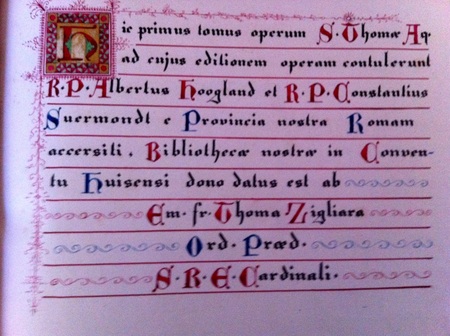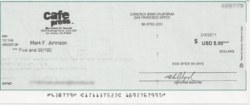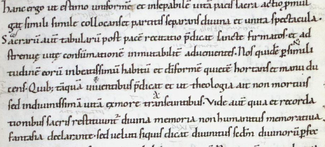Via Fr. Matthew Lamb of Ave Maria University, who knew Fr Busa in Italy in the 1970’s (and who suggested to Busa the idea of putting the Index Thomisticus on CD-ROM), comes a tribute from Dr. Stephen Ramsay, Associate Professor of English at the University of Nebraska-Lincoln, and a member of the digital humanities community, who greatly admired Fr. Busa’s work (and had corresponded with him):
(Note: reposted with permission of Dr. Ramsay):
Fr. Roberto Busa, S.J. (1913-2011)
Last night, I learned of the passing of Roberto Busa – a man that many consider the founder of Digital Humanities.
In recent years, people have called that lofty title into question, and not without justice. It seems that Busa was one among the many who were striving to bring computer technology – then in its early infancy – to bear on humanistic problems back in the forties. Like most DH scholars today, he was part of a much wider intellectual network.
But when I was starting out in the field, it was taken more-or-less for granted that Busa had started it all, and it’s not difficult to understand why. He was a Jesuit – a member of that most troublesome of religious orders, universally renowned both for its learning and for its many provocations both theological and disciplinary. His project recalled the ancient roots of the European university itself: a massive concordance to the works of Thomas Aquinas, who was himself a scholar and an intellectual revolutionary. It’s undoubtedly the case that many at the time were thinking of ways to use computers to conduct research in the humanities, but the scale and sweep of Busa’s project stands alone. It’s a story about old becoming new, and yet about continuity with the past.
His 1980 essay “The Annals of Humanities Computing: The Index Thomisticus” used to be required reading of sorts for people starting out, and it’s still my favorite. It’s a personal essay on how the Index came to be. The beginning is unforgettable:
I entered the Jesuit order in 1933. I was then 20. Later my superior asked me: “Would you like to become a professor?”
“In no way!” My wish was to become a missionary to take care of the poor.
“Good. You’ll do it, all the same.”
The subject of Busa’s research – and the occasion for creating the Index – was detailed study of the notion of “presence” in Thomas. Perhaps the New Criticism was taking hold in some other part of the world, but for Busa, philology was the proper hermeneutical framework.
[A]ll functional or grammatical words (which in my mind are not “empty” at all but philosophically rich) manifest the deepest logic of being which generates the basic structures of human discourse. It is this basic logic that allows the transfer from what the words mean today to what they meant to the writer.
The methodology for exploring that logic was clear enough:
According to the scholarly practices, I first searched through tables and subject indexes for the word praesens and praesentia. […] My next step was to write out by hand 10,000 3” X 5” cards, each containing a sentence with the word in or a word connected with in. Grand games of solitaire followed.
Busa himself eschewed the title of founder, and goes out of his way in this essay to list the others whom he thought were far ahead of him. But how can we deny the title to someone who writes:
It was clear to me, however, that to process texts containing more than ten million words, I had to look for some kind of machinery.
(If you’re not ready to do the first ten million by hand, you’re simply not in the good Father’s philological league).
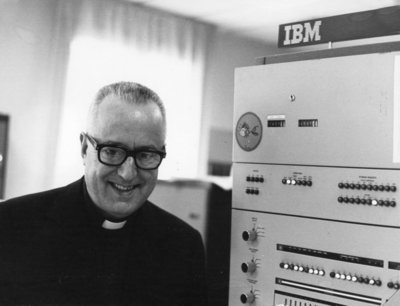
He eventually made his way to IBM. In fact, he made his way to the office of Thomas Watson himself:
I knew, the day I was to meet Thomas J. Watson, Sr., that he had on his desk a report which said that IBM machines could never do what I wanted. I had seen in the waiting room a small poster imprinted with the words, “the difficult we do right away; the impossible takes a little longer,” (IBM always loved slogans). I took it with me into Mr. Watson’s office. Sitting in front of him and sensing the tremendous power of his mind, I was inspired to say: “It is not right to say ‘no’ before you have tried.” I took out the poster and showed him his own slogan. He agreed that IBM would cooperate with my project until it was completed “provided that you do not change IBM into International Busa Machines.” I had already informed him that, because my superiors had given me time, encouragement, their blessings and much holy water, but unfortunately no money, I could recompense IBM in any way except financially. That was providential!
Is it any wonder that Busa became the patron saint of DH? John Unsworth, in a talk a few years ago, noted, “Most disciplines can’t point to a founding moment, much less a divine one.”
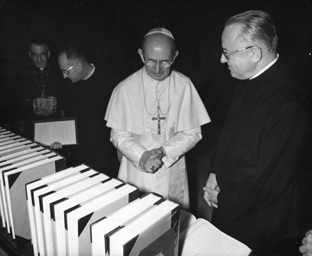
(I assume the non-DH-er in that photograph is Pope Paul VI)
And then there’s this:
I feel like a tight-rope walker who has reached the other end. It seems to me like Providence. Since man is a child of God and the technology is a child of man, I think that God regards technology the way a grandfather regards his grandchild. And for me personally, it is satisfying to realize that I have taken seriously my service to linguistic research.
Those words, written thirty years ago, are of a man who intends to live long and well.
And he did.




